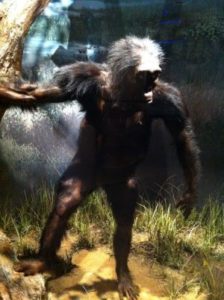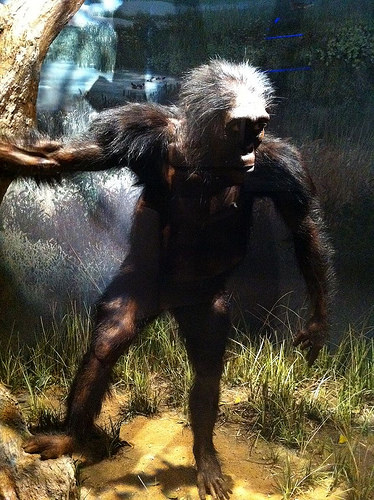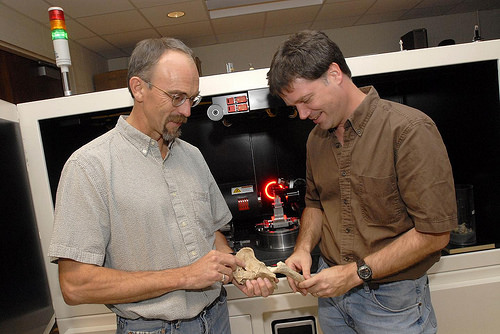
UNIVERSITY OF TEXAS AT AUSTIN—Lucy, the most famous fossil of a human ancestor, probably died after falling from a tree, according to a study appearing in Nature led by researchers at The University of Texas at Austin.
Lucy, a 3.18-million-year-old specimen of Australopithecus afarensis—or “southern ape of Afar”—is among the oldest, most complete skeletons of any adult, erect-walking human ancestor. Since her discovery in the Afar region of Ethiopia in 1974 by Arizona State University anthropologist Donald Johanson and graduate student Tom Gray, Lucy—a terrestrial biped—has been at the center of a vigorous debate about whether this ancient species also spent time in the trees.
“It is ironic that the fossil at the center of a debate about the role of arborealism in human evolution likely died from injuries suffered from a fall out of a tree,” said lead author John Kappelman, a UT Austin anthropology and geological sciences professor.
Kappelman first studied Lucy during her U.S. museum tour in 2008, when the fossil detoured to the High-Resolution X-ray Computed Tomography Facility (UTCT) in the UT Jackson School of Geosciences—a machine designed to scan through materials as solid as a rock and at a higher resolution than medical CT. For 10 days, Kappelman and geological sciences professor Richard Ketcham carefully scanned all of her 40-percent-complete skeleton to create a digital archive of more than 35,000 CT slices.
“Lucy is precious. There’s only one Lucy, and you want to study her as much as possible,” Ketcham said. “CT is nondestructive. So you can see what is inside, the internal details and arrangement of the internal bones.”
________________________________________
Representation of Lucy as depicted at the Natioanl Museum of Natural History, Washington, D.C. Mpinedag, Wikimedia Commons
____________________________________________________
Studying Lucy and her scans, Kappelman noticed something unusual: The end of the right humerus was fractured in a manner not normally seen in fossils, preserving a series of sharp, clean breaks with tiny bone fragments and slivers still in place.
“This compressive fracture results when the hand hits the ground during a fall, impacting the elements of the shoulder against one another to create a unique signature on the humerus,” said Kappelman, who consulted Dr. Stephen Pearce, an orthopedic surgeon at Austin Bone and Joint Clinic, using a modern human-scale, 3-D printed model of Lucy.
Pearce confirmed: The injury was consistent with a four-part proximal humerus fracture, caused by a fall from considerable height when the conscious victim stretched out an arm in an attempt to break the fall.
Kappelman observed similar but less severe fractures at the left shoulder and other compressive fractures throughout Lucy’s skeleton including a pilon fracture of the right ankle, a fractured left knee and pelvis, and even more subtle evidence such as a fractured first rib—”a hallmark of severe trauma”—all consistent with fractures caused by a fall. Without any evidence of healing, Kappelman concluded the breaks occurred perimortem, or near the time of death.
The question remained: How could Lucy have achieved the height necessary to produce such a high velocity fall and forceful impact? Kappelman argued that because of her small size—about 3 feet 6 inches and 60 pounds—Lucy probably foraged and sought nightly refuge in trees.
In comparing her with chimpanzees, Kappelman suggested Lucy probably fell from a height of more than 40 feet, hitting the ground at more than 35 miles per hour. Based on the pattern of breaks, Kappelman hypothesized that she landed feet-first before bracing herself with her arms when falling forward, and “death followed swiftly.”
“When the extent of Lucy’s multiple injuries first came into focus, her image popped into my mind’s eye, and I felt a jump of empathy across time and space,” Kappelman said. “Lucy was no longer simply a box of bones but in death became a real individual: a small, broken body lying helpless at the bottom of a tree.”
Kappelman conjectured that because Lucy was both terrestrial and arboreal, features that permitted her to move efficiently on the ground may have compromised her ability to climb trees, predisposing her species to more frequent falls. Using fracture patterns when present, future research may tell a more complete story of how ancient species lived and died.
In addition to the study, the Ethiopian National Museum provided access to a set of 3-D files of Lucy’s shoulder and knee for the public to download and print so that they can evaluate the hypothesis for themselves.
“This is the first time 3-D files have been released for any Ethiopian fossil hominin, and the Ethiopian officials are to be commended,” Kappelman said. “Lucy is leading the charge for the open sharing of digital data.”
________________________________________
UT Austin professors John Kappelman and Richard Ketcham examine casts of Lucy while scanning the original fossil (background). Credit: Marsha Miller
________________________________________
Source: Universty of Texas at Austin news release.
_____________________________________________________

______________________________________________
Travel and learn with Far Horizons.
____________________________________________
This richly illustrated issue includes the following stories: Recent findings shedding new light on the whereabouts of the remains of Philip of Macedon, father of Alexander the Great; how an archaeologist-sculptor is bringing bones of the dead back to life; archaeologists uncovering town life at the dawn of civilization; an exclusive interview with internationally acclaimed archaeologist James M. Adovasio about what makes the Meadowcroft Rockshelter prominent in the ongoing search for the first Americans; what archaeologists are finding at the site of the ancient city of Gath, the home town of the biblical Philistine giant, Goliath; and how scientists are redrawing the picture of human evolution in Europe. Find it on Amazon.com.









